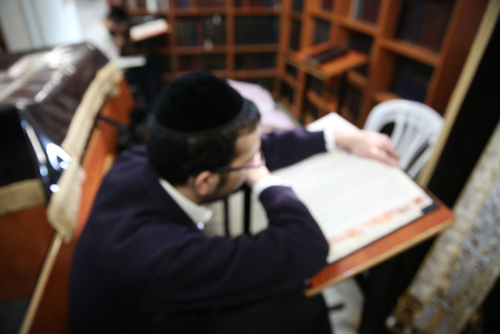< Lesson 13: How We Got from “Don’t Work on Shabbos” to All these Details…
Lesson 14: Friday Night Kiddush and Beyond – Laws & Customs
Welcome to my home! It’s Wednesday afternoon, but in Lesson 14, we’re going to try to recreate the atmosphere of a Friday night: coming home from shul, after attending the Kabbalas Shabbos (Welcoming Shabbos – or Shabbat) and the Maariv prayer services, from the time you come into the house until the time you say Kiddush, which is the beginning of the meal. How does one celebrate Shabbos at home?
Remember the Shabbos to Sanctify Her
The Torah says in Shemos (Exodus) 20:7, in the Aseres Hadibros (the Decalogue), “Zachor es yom haShabbos l’kadsho (remember the Shabbos to sanctify her).” We remember Shabbos when we bring Shabbos in, and when we bid Shabbos farewell. At the beginning of Shabbos we say the Kiddush; we bring the sanctity of Shabbos into our homes. In the blessing of Kiddush we mention the kedushas haShabbos – the sanctity of Shabbos. As we bid Shabbos farewell with the Havdalah ceremony, we point out the difference between the holy day of Shabbos and the weekdays after that.
The rabbis tell us in the Gemara in Shabbos that when a person comes home from synagogue on Friday night, they are escorted by two angels. The angels are created by the person’s good deeds that they do in preparing for Shabbos.
If, when they come home, the angels see that the atmosphere is the way Shabbos is supposed to be – the table is set properly, the family is dressed in their Shabbos finest, and the serenity in the home is the way it’s supposed to be, then the angels bless the family, and say, “Next Shabbos you should be blessed to have the same serenity, the same wonderful atmosphere in your home.”
If, unfortunately, it’s not that way – the table is not set and the people aren’t dressed in their Shabbos finest, and there isn’t serenity but rather there are people fighting with each other, then the angels say, “You don’t deserve the blessing,” and the next Shabbos will be the same thing.
Shalom Aleichem (Welcoming the Angels)
When we come to the home on Shabbos, we sing Shalom Aleichem. There are four stanzas in this song. Here is the basic meaning of each stanza:
- Shalom Aleichem – we greet the angels – welcome to you, the messengers of the Melech Malchei Hamlachim (King of kings of kings) – the Holy One Blessed be He – God.
- Boachem L’Shalom – come to my home – I’m welcoming you into my house.
- Barchuni L’Shalom – bless me please, I’m hoping that my house is one that merits the blessing of the angels.
- Tzeischem L’Shalom – you’ve done your job, hopefully you’ve blessed me. Now go and bless everyone else so they, too, can enjoy the blessings of Shabbos.
The Song of Eishes Chayil
After we sing Shalom Aleichem, the tradition is to sing, or say, Eishes Chayil, from the last chapter of Mishlei (Proverbs). King Solomon writes “Eishes chayil mi yimtza? (A woman of valor, who can find?)” We recognize that the strong Jewish home comes from a foundation of a woman who builds the home, prepares for Shabbos, cleans for Shabbos, and makes sure that the home is one that is able to be Shabbos’dik – Shabbos-like. In Eishes chayil, we recognize the woman of the house as being the anchor of the Jewish home.
Birkas HaBanim – Blessing the Children
After that, in many homes, it’s traditional for the father to bless the children. It’s very possible that at the time of candle lighting, the woman who lights candles – the mother, the wife – has blessed the children that are in the house. Then, the father/husband comes home and he says the traditional Birkas HaBanim – the Jewish blessing that is said for the children. (You can find it in many siddurim [prayer books], or if you have a zimron, a zemiros [Shabbos songs] book, you might find it before Kiddush.)
The traditional Birkas HaBanim is taken from the blessing that Yaakov Avinu (our patriarch Jacob) gave to Yosef (Joseph), regarding his sons (Bereishit 48:20): “Yesimcha Elokim k’Efraim uch’Menashe” – throughout the generations, parents will be blessing their children that they should be like Ephraim and Menashe. The same way that Yosef was able to raise his children in the galus, in the exile of Egypt, away from his father, to be strong, God-fearing people; we bless our children that they, too, should be like Ephraim and Menashe.
For daughters, the traditional Hebrew blessing is “Yesimcha Elokim k’Sara, Rivka Rochel, v’Leah” – we bless our daughters that they should be as great as the matriarchs Sarah, Rivka, Rochel and Leah.
After that, you put your hands on the head of your children and say the traditional priestly blessings: “Yivarechicha Hashem v’yishmirecha (May God bless you and guard you)…” – as found in the siddur.
At this point, it’s a good time for a father to bond with his children, express his appreciation of them, and give whatever bracha (blessing) he wishes to give them. Let them feel his warmth and let them tap into this excitement that the father has for the Shabbos that’s coming; let him help them grow into the appreciation of Shabbos.
(The bracha that I give my children is that you should be a gutte, zisse, ehrliche yid – a good, sweet, honest Jew – and, I tell my children – if you are that, then that’s good, and anything more than that is icing on the cake.)
How to Make Kiddush – The Ceremony
So, we’ve greeted the angels, we’ve acknowledged and recognized our wives, we’ve blessed our children, and now we come to say the Kiddush. “Zachor es yom hashabbos l’kadsho.” We are bringing the sanctity of Shabbos into our home.
The Cup of Wine
Kiddush is said holding a kos – a cup – of wine. There are laws:
- The cup must be clean both on the inside and the outside – it has to be washed (and still wet).
- It has to hold at least a revi’is, which is anywhere from 3oz to 5.5oz. In order to keep everyone happy, use a cup that’s 5.5oz.
- Don’t use a disposable – it doesn’t have the same importance, and so it’s cheapening the mitzvah. Many people have a silver cup. It doesn’t have to be, but again, to beautify the mitzvah, make it as nice as you could.
- It can’t be cracked, it has to be whole.
- See “Kiddush over Wine” below for more about the wine.
Connecting to God
Before beginning Kiddush, we should gaze at the candles for a moment. The rabbis tell us that if a person takes broad steps, he loses 1/500 of his vision. What does that mean? If a person gets caught up in rushing and the hubbub of daily life, if he gets so caught up in having too much to do and being burned with too many emails to answer and too many appointments to make, he can lose his focus and get sucked up, and his priorities to remember Hashem and his relationship with Hashem can be lost. So when we begin Shabbos, we look at the candles and focus on the sanctity of Shabbos, and we can realign our priorities to remember that there’s more than just what we’ve been doing for the six days of the week. Shabbos is a time that we can connect to God.
If you’ll notice, the first words of the kiddush that are said are, “Vayehi erev vayihi boker Yom Hashishi (It was evening and it was morning, the sixth day.)“ The six days of creation were over, “vayechulu hashamayim v’haaretz v’chol tz’vakam (and Hashem finished creating the heavens and the earth).“ If you look at the four words “Yom Hashishi Vayechulu Hashamayim” in Hebrew, you can see that the first letters of those four words – yud, hey, vav, and hey, spell out Hashem’s name.
Before we begin Kiddush, we want to make sure that our focus is correct. What is Shabbos all about? Ask people, what does Shabbos mean to you? It’s a day of rest, a day to spend time with our family – definitely so, but there’s more than that. Shabbos is a day of emunah, faith, in Hashem. For six days Hashem created the world – there is a creator of the world! And Hashem created Shabbos for us to tap into that realization. Hashem created the world and gave us a life with meaning and purpose. So we begin Kiddush this way, to focus on this, that Shabbos is a day that we are connecting and reconnecting with God, with the Ribono shel Olam (Master of the World).
Kiddush Over Wine
We pour the cup of wine. It should be filled to the top.
- You can either use wine, or grape juice (which is halachically considered like wine), that hasn’t been drunk from – it has to be wine that you’re going to use specifically for the mitzvah.
- Kiddush on Friday night cannot be made on scotch or any other drink. If you don’t have any wine to use for Kiddush, you should recite the Kiddush over the challahs, and instead of making the blessing borei pri hagafen, you say hamotzi lechem min ha’aretz and then continue the recitation of the Kiddush.
The Recitation of Kiddush
- Pick up the cup with two hands, and then, hold it in your right hand if you’re a righty, or your left hand if you’re a lefty. Hold it in the palm of your hand.
- Recite the paragraph of “vayechulu hashamayim vhaaretz“, then the bracha of borei pri hagafen as you’re looking at the candles. Then you say the bracha of Baruch Ata Hashem, mikadesh haShabbos.
- Everyone around the table – your wife, your children, your guests that are there – also have the mitzvah of Kiddush, so when you say the bracha, they should be listening intently and answering amen to the bracha.
- Then you drink from the wine, and everyone around the table should also drink from the wine. How much of the wine should you drink? The majority of a revi’is should be drunk, which is at least two ounces. First drink some yourself, and then distribute to everyone else who is at the table.
Sit or Stand?
There are different customs as to whether you should stand or sit when reciting Kiddush. What’s the issue?
The issue for those that say you should sit down is that since the people you’re saying the bracha for have to listen, when they’re sitting around at the table it’s easier to concentrate. When people are standing around and looking around, it’s harder to concentrate. So according the strict halachah, it’s really better to sit down when you say the Kiddush.
Some people stand when saying the paragraph of “Vayechulu“. As we’ll see in the next episode, in which we’ll translate and explain and give meaning to the Kiddush, the first paragraph is really testimony that Hashem created the world in six days. So that should be said standing. Some sit down when saying the second bracha, and some people stand for the whole thing.
Kiddush Samuch l’Seudah
Immediately after saying Kiddush, you should go to the sink to wash your hands (with a cup, twice on each hand, followed by the bracha of al netilas yadayim), and make the bracha of hamotzi on the bread. One of the laws of Kiddush is that it should be samuch l’seudah – right at the time that you’re eating. Kiddush is the beginning of the meal so you say the Kiddush and then go straight to wash.
Two Covered Loaves of Challah Bread
If you’ll notice, the challahs that were at the table are covered with a challah cover. Traditionally you have two loaves of challah – called lechem mishnah – with a challah covering, and something that’s under it – like a tray. Why do we eat challah on Shabbos? Why two loaves? And why the tray and the cover?
- The two loaves of challah are symbolic of the man (manna) that fell and fed the Jews in the desert for 40 years. When God took us out of Egypt, we went through a desert. There’s no food to be had in the desert, and miraculously Hashem had man fall from the heavens to feed us. On Friday, a double portion of man fell, for Friday and for Shabbos, because on Shabbos, there’s no preparation of food, no work – it’s a day you spend with Hashem. We symbolize the double portion of man with the two challahs.
- When the man fell, there was a layer of dew beneath it, and a layer of dew on top of it, so it was sandwiched. We do the same with the challahs and have something on top and something underneath.
- Another reason why we keep the challah covered is to teach us the sensitivity to others’ feelings:
- Normally when you are eating a meal at which you’re washing and eating bread, hamotzi lechem min ha’aretz is the first bracha that’s said. It’s the most chashuv, the most special of all the brachos, and goes before any other bracha. At a meal that you’re eating bread and drinking wine, you should really wash first.
- On Shabbos, however, because we want to begin the meal with Kiddush, which is said over a cup of wine, we make the borei pri hagafen on the wine before the hamotzi lechem min ha’aretz on the bread. If the bread would have feelings, it would be insulted – you’re passing over me to make a bracha of borei pri hagafen – that’s not usually done. So, to reinforce in us that we should always be sensitive to others’ feelings, we cover the challahs. Even when doing a mitzvah, make sure you’re not trampling on other people’s feelings as you’re doing the mitzvah.
Kiddush Sets the Tone for the Meal
Of course it goes without saying that Kiddush is the beginning of the meal, and it should be setting the tone for the meal. You’ve looked at the candles as you recited the bracha of borei pri hagafen to refocus your priorities. You’ve said, “Vayehi erev vayehi boker yom hashishi vayechulu hashamayim,” including Hashem’s name.
We’re trying to focus on the fact that this meal is a meal where Hashem is present, so to speak. So, you should have a Chumash at the table, or some sefer (Torah book) which you can discuss at the table, if you’re prepared beforehand about the portion of the week that will be read in shul. Discuss with your children what they learned in school, in yeshiva that week, and make sure that you take the opportunity to give over to your children the Torah principles that are important to you. You have those principles and can use the Shabbos meal as the opportunity to be able to give them this legacy of Shabbos and its sanctity. It should be transmitted to them with love, and im yirtzeh Hashem, with God’s help, we’ll translate the Kiddush and explain what it is we’re doing as we say the Kiddush.
Resources
For an in-depth study of these laws, see:
The Radiance of Shabbos by Rabbi Simcha Bunim Cohen (Mesorah Publications/Artscroll) – One in a series on the laws of Shabbos.
To learn the Shabbos songs, such as Shalom Aleichem, check out Shabbos Zemiros on the Ohr Somayach website: https://audio.ohr.edu/track/id=1535
(Editor’s note: Oorah’s TheZone Zemiros audio album, mostly a loose translation of many of the regular Shabbos songs to commonly sung tunes, has inspired many and is a great resource to learn the meaning of the traditional songs. You can listen to and download TheZone Zemiros at shmorg.org.)
Lesson 15: Friday Night Kiddush – Translation and Commentary >
Rabbi Pinchus Rappaport is a respected rabbi who received his Rabbinic ordination from Yeshiva of Staten Island, under the tutelage of Rabbi Moshe Feinstein. He currently serves as a rabbi in Brooklyn, NY.
Since halachic opinions vary among the rabbis of different communities, Oorah and Rabbi Rappaport encourage you to direct any questions to, and get halachic guidance from, your local Orthodox rabbi. You may, however, rely on this video and email Rabbi Rappaport with questions in the interim, at askrpr2@gmail.com.
Shared as a zechus l’iluy nishmas Moshe Zeev ben Aryeh Leib


